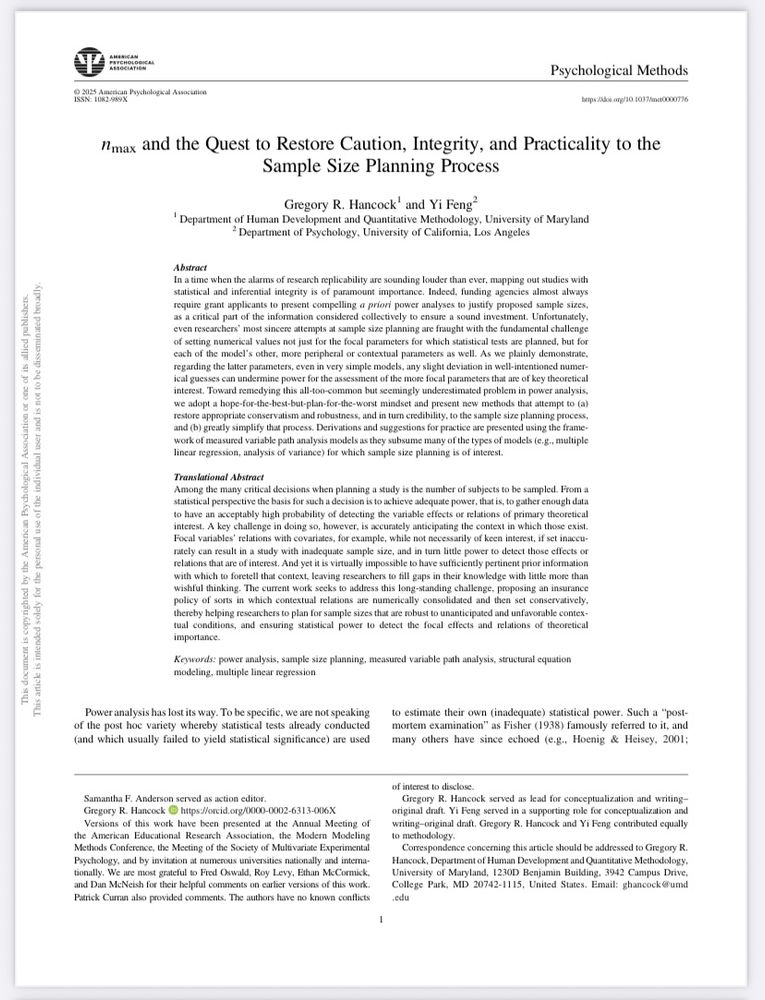Love to see a registered report that reinforces why the registered report is such a valuable tool
07.10.2025 14:10 — 👍 3 🔁 0 💬 0 📌 0
Interactions are difficult to detect in field studies as they are typically tiny--very small to start with and made smaller by the joint unreliabilities of the components. Here, we find some but the contribution to explained variance is negligible. Call off the search. It is not worth the effort.
06.10.2025 15:39 — 👍 3 🔁 1 💬 0 📌 0
Pretty excited about this one. In this paper, we discuss the replication/credibility crisis, the factors that contribute to it, and clinical psychology's slow (really slow) progress in dealing with it. We offer a competency-based fraemwork for improving our training of future scholars.
1/2
02.10.2025 16:24 — 👍 17 🔁 6 💬 1 📌 0
Rigorous science is transparent science.
02.10.2025 15:26 — 👍 10 🔁 2 💬 0 📌 0
New paper led by @drlynam.bsky.social on the need for more training in and engagement with open science practices in clinical psych programs. It has been difficult to make progress due to a variety of barriers, including students working in labs uninterested or hostile to these approaches.
02.10.2025 12:36 — 👍 33 🔁 14 💬 1 📌 4
OSF
Just accepted from @vizecolin.bsky.social and myself. We coded Open Science practices (preregistration, RRs, open data, and open code) from 2021 to 2024 in two personality disorder journals (JPD, PDTRT) and three personality journals *JOP JRP, and EJP).
osf.io/preprints/ps...
1/5
19.09.2025 14:50 — 👍 6 🔁 2 💬 1 📌 0
Lol 100 percent. I feel similarly when diving into this literature and posted this a little while ago hoping for some clarity (and got crickets)
bsky.app/profile/nphi...
19.09.2025 14:00 — 👍 2 🔁 0 💬 1 📌 0
This imagery is the kind of thing you see in video games to let you know you’re in a totalitarian city or country.
27.08.2025 15:28 — 👍 5979 🔁 1224 💬 186 📌 42

Models as Prediction Machines: How to Convert Confusing Coefficients into Clear Quantities
Abstract
Psychological researchers usually make sense of regression models by interpreting coefficient estimates directly. This works well enough for simple linear models, but is more challenging for more complex models with, for example, categorical variables, interactions, non-linearities, and hierarchical structures. Here, we introduce an alternative approach to making sense of statistical models. The central idea is to abstract away from the mechanics of estimation, and to treat models as “counterfactual prediction machines,” which are subsequently queried to estimate quantities and conduct tests that matter substantively. This workflow is model-agnostic; it can be applied in a consistent fashion to draw causal or descriptive inference from a wide range of models. We illustrate how to implement this workflow with the marginaleffects package, which supports over 100 different classes of models in R and Python, and present two worked examples. These examples show how the workflow can be applied across designs (e.g., observational study, randomized experiment) to answer different research questions (e.g., associations, causal effects, effect heterogeneity) while facing various challenges (e.g., controlling for confounders in a flexible manner, modelling ordinal outcomes, and interpreting non-linear models).

Figure illustrating model predictions. On the X-axis the predictor, annual gross income in Euro. On the Y-axis the outcome, predicted life satisfaction. A solid line marks the curve of predictions on which individual data points are marked as model-implied outcomes at incomes of interest. Comparing two such predictions gives us a comparison. We can also fit a tangent to the line of predictions, which illustrates the slope at any given point of the curve.

A figure illustrating various ways to include age as a predictor in a model. On the x-axis age (predictor), on the y-axis the outcome (model-implied importance of friends, including confidence intervals).
Illustrated are
1. age as a categorical predictor, resultings in the predictions bouncing around a lot with wide confidence intervals
2. age as a linear predictor, which forces a straight line through the data points that has a very tight confidence band and
3. age splines, which lies somewhere in between as it smoothly follows the data but has more uncertainty than the straight line.
Ever stared at a table of regression coefficients & wondered what you're doing with your life?
Very excited to share this gentle introduction to another way of making sense of statistical models (w @vincentab.bsky.social)
Preprint: doi.org/10.31234/osf...
Website: j-rohrer.github.io/marginal-psy...
25.08.2025 11:49 — 👍 943 🔁 283 💬 48 📌 19
This one and McCabe et al 2022 from @kevinmking.bsky.social's group are both awesome in thinking about the interpretability of these types of effects
22.08.2025 19:46 — 👍 6 🔁 0 💬 1 📌 0

For those interested, here is a link to a new power paper:
Hancock, G. R., & Feng, Y. (2026). nmax and the quest to
restore caution, integrity, and practicality to the sample size planning process. Psychological Methods.
yifengquant.github.io/Publications...
19.08.2025 01:04 — 👍 63 🔁 24 💬 4 📌 2
Really appreciate the authors’ efforts to differentiate these practices. I’ve definitely seen the term “preregistration” used to describe each of these three (registration, protocol, analysis plan) in isolation of one another, so it’s great to have a framework to address these jingle-jangle issues
14.08.2025 21:49 — 👍 4 🔁 0 💬 0 📌 0
We don't really think one will be able to cleanly divide the personality disorders from Axis I disorders. We argue (following Lilienfeld's writing on psychopathology's distinction from normality) that it is a Roschian construct such that there won't be an easy way to cleave PDs from other disorders.
09.08.2025 15:51 — 👍 7 🔁 1 💬 3 📌 0

There Is an Information Blackout at Florida’s ‘Alligator Alcatraz’ Migrant Detention Camp
Public records related to Florida’s so-called “Alligator Alcatraz” migrant detention camp have...
Over 90 pages of "Alligator Alcatraz" files disappeared as I was looking at them and reporting on the situation. Our public records requests are getting stonewalled. A slew of experts told me this all seems to be illegal. talkingpointsmemo.com/muckraker/th...
05.08.2025 20:35 — 👍 4888 🔁 2203 💬 168 📌 114
Yeah, that checking the box was my intuition, too. Not surprising that these types of cases are pretty fringe though
26.07.2025 14:51 — 👍 2 🔁 0 💬 0 📌 0
Thanks for the response! Out of curiosity, how are y’all coding it if the raw data is coupled with open code showing the pipeline from raw data to clean data (as described in the manuscript)?
26.07.2025 14:28 — 👍 0 🔁 0 💬 1 📌 0
Let us know what you think!
25.07.2025 20:12 — 👍 0 🔁 0 💬 0 📌 0
Question for my open science peeps! @nphillips36.bsky.social and I are working on a lit review where we’re coding whether or not manuscripts have open data.
How should we handle cases where authors provide links to big, “open” datasets? In some of these cases, the data are hidden behind so much…
25.07.2025 17:27 — 👍 6 🔁 3 💬 6 📌 1
Reposting for the morning crowd — recs would be appreciated!
25.07.2025 13:12 — 👍 0 🔁 0 💬 0 📌 0
For the quanty folks: Any go-to readings comparing approaches to modeling nonlinearity? Seeing more on splines, fractional polynomials, etc., but struggling to find clear head-to-head comparisons or discussions of tradeoffs.
24.07.2025 20:06 — 👍 0 🔁 0 💬 0 📌 2
Final vote. 50-50. VP breaks the tie.
One single GOP Senator could have stopped this abomination. Saved millions of parents from watching their child go hungry. Saved the lives destroyed when Medicaid disappears.
They will all live forever with the horror of this bill.
01.07.2025 16:07 — 👍 34997 🔁 10996 💬 2638 📌 1168
Same here lol -- I did not post it separately on purpose
30.06.2025 19:07 — 👍 1 🔁 0 💬 0 📌 0
It's a good time to be an antagonism researcher (because of this issue and for the many other reasons)
30.06.2025 18:30 — 👍 1 🔁 0 💬 1 📌 1
Would love to see one of these reasonable applications, if you have any examples in mind. Thanks!
20.06.2025 19:24 — 👍 1 🔁 0 💬 0 📌 0
@drandreahoward.bsky.social, hold my beer..
Latent class growth models are worse than useless, and we've known this for more than 20 years.
(See Bauer 2007)
20.06.2025 19:05 — 👍 121 🔁 32 💬 10 📌 7
Very cool! I appreciate the thoughtful response and congrats on a really interesting paper
18.06.2025 21:46 — 👍 1 🔁 0 💬 1 📌 0
Forensic Psychology Training Director, Associate Professor @ University of New Mexico School of Medicine. Trying to leave the forensic psych world better than I found it. Perpetually food-motivated. http://hsc.unm.edu/directory/perillo-anthony.html
Staff writer at The Atlantic. Cat guy, democracy defender. Actor for a day on Succession, Jeopardy champ. New Englander and curmudgeon.
Official account of the European Association of Personality Psychology (EAPP)
Incoming Assistant Professor of HCI at Carnegie Mellon studying the psychology of technology. NSF postdoc at NYU, PhD from Cambridge, BA from Stanford. stevenrathje.com
Psychological scientist working at the University of Washington. Substance use, emotion, motivation, decision-making. jonasdora.com
The CCP @KU_Leuven led by Prof. Inez Myin -Germeys (@inezgermeys.bsky.social) & Prof. Olivia J. Kirtley (@oliviajkirtley.bsky.social).
Associate Professor of Political Science at Northwestern University
alexandercoppock.com
Persuasion in Parallel: https://alexandercoppock.com/coppock_2023.html
Research Design: Declaration, Diagnosis, and Redesign: book.declaredesign.org
not very committed to sparkle motion
Prof @ Uni of Cologne
Precision Psychiatry, Autonomic Neuroscience, Neuromodulation. Editor: European Child and Adolescent Psychiatry, Journal of Child Psychology and Psychiatry
www.koeniglab.de
Research Fellow U-M 🇺🇸, ENIGMA-Antisocial Behavior 🧠 l postdoc UofB CHBH 🇬🇧 | PhD UdeM 🇨🇦⚜️
Co-founder & editor, Works in Progress. Writer, Scientific Discovery. Podcaster, Hard Drugs. Advisor, Open Philanthropy. // Previously at Our World in Data.
Newsletter: https://scientificdiscovery.dev
Podcast: https://harddrugs.worksinprogress.co
🏳️🌈
Clinical psychologist and doctoral researcher interested in personality and volitional personality change interventions.
Philosopher of science; works on evo bio, ecology, some history of bio/philo; kant, organisms, emergence, complexity, algo & big data etc
Latest Books : Why ? (Stanford UP); Death (Palgrave); Societes du profilage (Payot)
IHPST (CNRS/Paris I sorbonne)
Clinical psychologist and assistant professor at Emory University School of Medicine. Research and clinical areas: PTSD, OCD, exposure therapy, ACT, VR/XR, AI, mHealth, language, and improv. @ABCTnow @myACBS @EmoryVeterans
Child Psychologist; Associate Professor, Harvard Medical School; Author; New Book -Bright Kids Who Couldn’t Care Less: How to Rekindle Your Child’s Motivation @guilford www.ellenbraatenphd.com
Epidemiologist + Statistician | Clinical Research Facility - University College Cork | UCC School of Public Health | #ClinicalTrials #Epidemiology #Statistics #RStats #WBE #IDSurveillance
Views mine -> https://statsepi.substack.com/
Personality & Organisational Psychology PhD student, University of Manchester
Temple Clinical Psychology PhD Student 🦉 | Heterogeneity in Brain Networks & Psychopathology | First Gen | NRSA F31 Fellow
Brain imager (and occasional tinkerer) @ The University of New Mexico. https://www.hogeveen-lab.com/








